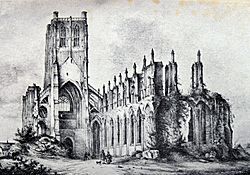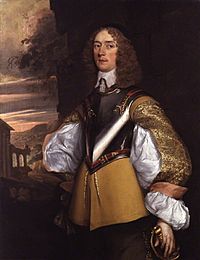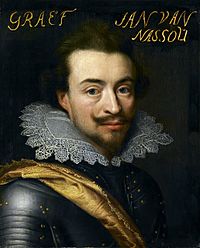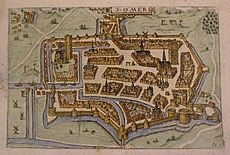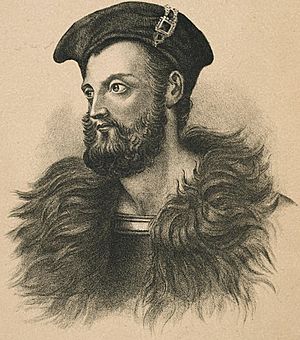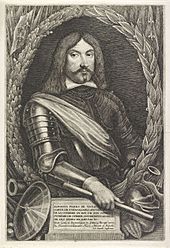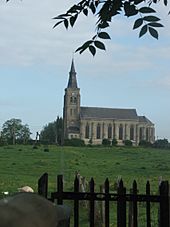Siege of Saint-Omer facts for kids
Quick facts for kids Siege of Saint-Omer |
|||||||
|---|---|---|---|---|---|---|---|
| Part of the Thirty Years' War and the Franco-Spanish War (1635-1659) |
|||||||
 The relief of Saint-Omer by Peter Snayers. Oil on canvas. Museo del Prado, Madrid. |
|||||||
|
|||||||
| Belligerents | |||||||
| Commanders and leaders | |||||||
| Strength | |||||||
| 20,000 infantry and cavalry | 10,000 infantry, 3,000 cavalry (Châtillon) 16,000 infantry and cavalry (La Force) |
||||||
| Casualties and losses | |||||||
| Unknown | 4,000 dead or wounded | ||||||
The Siege of Saint-Omer was an important battle during the Thirty Years' War and the Franco-Spanish War (1635-1659). It took place from May 24 to July 16, 1638. A French army, led by Gaspard III de Coligny, tried to capture the city of Saint-Omer in Flanders. The city was defended by a small group of soldiers under Lancelot II Schetz.
Even though the French had some early wins, a Spanish army arrived to help. This army was led by Thomas Francis, Prince of Carignano. They surprised the French and built a small fort right in the middle of the French lines. Another French army, led by Maréchal de La Force, was sent to help. But then, another Imperial-Spanish force, led by Ottavio Piccolomini, entered Saint-Omer. This made the French generals decide to leave.
Contents
Why the Siege Happened
Europe at War
In 1635, Europe was in the middle of the Thirty Years' War. This was a huge conflict involving many countries. France and the Dutch Republic were fighting against Spain. They both invaded the Spanish Netherlands (which is now Belgium and parts of the Netherlands).
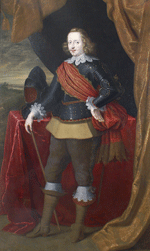
The Spanish army, led by the Cardinal-Infante Ferdinand, pulled back to protect Brussels. The French and Dutch armies tried to capture Leuven, but they failed. This was because they had problems with supplies and many soldiers got sick.
Spain's Plans
After this, Spain fought back. They pushed the French and Dutch armies away. Spain even captured an important Dutch fort called Schenkenschans. This fort was very hard to take back.
Meanwhile, France's leader, Cardinal Richelieu, decided to focus their efforts in another area, the Rhineland. Spain's leader, Olivares, wanted to keep fighting in the Netherlands.
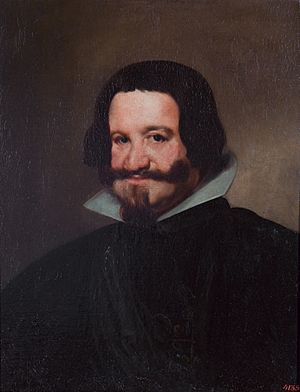
In 1636, Spain launched an attack into France. They captured some forts, which worried the French King, Louis XIII. France had to bring its armies back to defend Paris. Spain captured the important fortress of Corbie. But later, France managed to take Corbie back.
New Goals for Spain
In 1637, the Dutch attacked Breda, a very important Spanish fortress. Spain tried to help the city, but they couldn't. Breda was captured by the Dutch.
For the 1638 fighting season, King Philip IV told Cardinal-Infante Ferdinand to attack the Dutch. He wanted to force them to make peace and give back lands they had captured. One main goal was to take Rheinberg, which would give Spain a crossing point on the Lower Rhine river.
The Siege Begins
First Attacks
The French general, Châtillon, saw that Saint-Omer had only about 1,300 soldiers. This was not enough to defend the town properly. So, he decided to lay siege to it. By May 26, his army had surrounded the town.
Three days later, the French captured a small outpost called Arques. Its 50 defenders quickly gave up. Châtillon then set up his main camp in Arques.
Next, the French attacked the St. Bertin de Clairmarais Abbey. This was a good defensive spot. The defenders fought hard but ran out of gunpowder and had to surrender. Châtillon's main goal was to cut off Saint-Omer from all help. He sent troops to capture forts between Ardres and Saint-Omer to secure his supplies.
Spanish Reinforcements Arrive
A Spanish general, Paul Bernard de Fontaine, moved his troops to Watten. From there, he sent 6 companies of soldiers into Saint-Omer to help defend it. Captain Luis de Mieses took command of the city's defenders. The previous commander, Lancelot II, Count of Grobbendock, was ordered to defend a key outpost called Bacq. This position was vital for receiving help.
Châtillon's officers told him he needed to take Bacq. The French general avoided a direct attack. But the Baron of Wezemaal, seeing his weak position, pulled his troops back into Saint-Omer. This allowed the French to take Bacq.
After securing Bacq, Châtillon captured three more small forts. These forts defended the Canal de Neufossé. The strongest one surrendered without a fight. The other two were taken by force, and most of their defenders were killed. French cavalry then crossed into Flanders, where they looted Cassel and other villages.
The First Relief Attempt
Spanish Army Advances
Count Ernest von Isenburg-Grenzau gathered his troops and marched towards Flanders. He joined forces with other Spanish units. The Prince Thomas of Carignano then took command of this Spanish army near Poperinge. Most of his soldiers stayed in nearby villages.
The Spanish leaders discussed how to help Saint-Omer. It was a difficult task because the French held most of the forts around the town. Also, the French army was twice as big as the Spanish. Châtillon's soldiers had not yet started digging trenches around the town. This was because Châtillon was waiting for the Dutch army to attack Antwerp. Saint-Omer's defenders, however, desperately needed supplies.
A Bold Plan
Thomas of Carignano decided to help the town alone. He knew the Imperial army under Ottavio Piccolomini couldn't arrive in time. He wanted to get supplies into Saint-Omer so the defenders could keep fighting.
He sent four groups of 1,000 men each. These groups included Spanish, Neapolitan, German, English, and Irish soldiers. They were also joined by 2,000 cavalrymen.
At the same time, a Spanish officer named Paolo Fanfanelli was sent to capture the tower of the Abbey of Watten. This tower was on a hill and guarded by 50 French soldiers. The French soldiers, lacking supplies and seeing the large Spanish army, quickly surrendered.
Fighting at Watten
Châtillon had sent two French regiments to Watten. But they arrived after the tower had surrendered. The French colonels, Espagni and Fouquerolles, found it hard to retreat. They formed their regiments in a field and tried to negotiate.
However, the Spanish attacked them. Spanish cavalry quickly arrived and overwhelmed the French troops. The French soldiers threw down their weapons and asked for mercy. The Spanish accepted their surrender. The Spanish took all the French supplies and belongings. The Spanish lost only 2 captains and 5 soldiers. The French lost Colonel Fouquerolles, 5 captains, and 22 soldiers killed. Many more were captured.
Supplies Reach Saint-Omer
Thomas of Carignano decided not to have a big battle. Instead, he planned a secret operation to get supplies into Saint-Omer. Captain Luis de Mieses left the town by boat through the canals. He met Spanish soldiers and supplies at the village of Nieurlet.
300 German, 200 Italian, and 100 English soldiers, along with gunpowder and matches, were loaded onto boats. They were brought into Saint-Omer. The French fired at the boats, but the supplies and soldiers made it into the town safely. Thomas of Carignano was happy with the mission's success and returned to his camp.
The Siege Continues
French Fortifications
Even though Saint-Omer had received some help, the pressure on the town grew. The French continued to build forts and defenses around the city. Châtillon directed these works. However, the marshy land around Saint-Omer made it very hard to dig trenches and move supplies.
One of the French officers started building a fort on a raised path (levee) to protect Châtillon's supplies. The Spanish quickly captured it. Châtillon, worried, asked King Louis XIII to send more troops. The king was surprised, but he eventually ordered another French army, led by La Force, to move closer to Saint-Omer. La Force set up his camp at Zutkerque.
Skirmishes and Attacks
Thomas of Carignano sent Spanish cavalry to attack a new French fort near La Force's position. But they decided it was too risky. The Prince then reinforced the village of Ruminghem to prevent the French from taking it.
By the night of June 29, French soldiers began digging trenches towards the walls of Saint-Omer. The Spanish defenders sent a messenger to warn Thomas of Carignano. The French focused their siege work on Saint Michel hill, which was not swampy. They set up cannons there and heavily bombed the town.
The leaders inside Saint-Omer decided to defend the most exposed parts of the walls with Spanish soldiers. On July 2, some Spanish soldiers tried to attack the French works but were pushed back.
Thomas of Carignano decided to capture a French fort near Bacq. This fort was called Fort St. Jean. He worried that the people of Saint-Omer might revolt against the defenders. For the attack, he sent 600 Spanish, 200 German, and 200 Irish soldiers, along with cannons and cavalry.
Taking Fort St. Jean
The Attack Plan
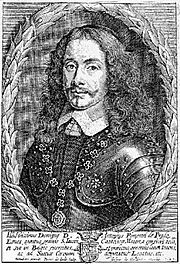
The Spanish troops arrived at Fort St. Jean at night. They set up their cannons. A French guard heard them and fired his musket, alerting the fort. The Spanish commander ordered his soldiers to dig trenches. When it got dark and started raining, the Spanish cannons opened fire. The French inside the fort fired back with muskets.
A Spanish cannonball accidentally killed one Spanish soldier and wounded another. The Spanish commander stopped firing and sent a drummer to tell the French to surrender. The French officer in charge said they expected La Force to help them and would not surrender.
French Counter-Attack
Meanwhile, Johann von Nassau-Siegen, leading some Spanish cavalry, met French troops and began to retreat. La Force immediately sent his cavalry to attack the Spanish rear-guard. The Spanish cavalry was almost defeated. But a group of Spanish musketeers, hidden in hedges, managed to hold off the attack. This gave the Spanish cavalry time to retreat.
The Spanish commander, seeing that French help was coming, asked Thomas of Carignano for permission to attack the fort. Permission was given.
Fort St. Jean Falls
The Spanish attacked the fort with three groups of 200 men. They used ladders and wood to cross the defenses. With cannon support, they climbed the walls. The first officer to enter the fort was wounded but kept leading his soldiers.
The French soldiers inside were surprised and could barely fire a shot. 135 French soldiers were killed, a few escaped, and 4 were captured. The Spanish lost only 2 soldiers killed and 7 wounded.
La Force's relief force, finding the few French soldiers who had escaped, stopped. The Spanish then placed 100 soldiers in the fort, with another 300 nearby. The next day, more German soldiers entered the fort. The Spanish commander was congratulated for his success.
A skirmish happened the next day when the French tried to retake the fort. They were pushed back twice. The battle lasted until night. The French lost about 800 men killed or wounded, while the Spanish lost only 27.
The Final Relief
Two-Part Attack
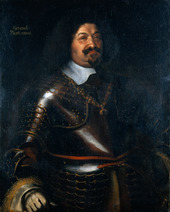
The Spanish relief force planned to attack in two parts. One part, led by Thomas of Carignano, would move through the marshes. The other part, led by Piccolomini, would attack Châtillon's main defenses. Most of the combined Spanish and Imperial cavalry was sent to stop La Force from joining Châtillon. Another group of soldiers would capture a fort on the Aa river.
Châtillon realized his long defense lines were hard to guard. He asked La Force to bring his army inside the French fortifications, which La Force did. La Force also brought a supply convoy. Spanish cavalry was seen advancing, which worried the French. A French patrol captured two disguised men trying to reach the Spanish army. Châtillon then tried to guard a raised path that connected his forces, but the Spanish had already taken it.
Capturing More Forts
The French had three forts defending the path from the marshes. The strongest, Niursote, was defended by 600 soldiers. But it surrendered after the first Spanish attack. A second fort, Esquenque, also surrendered because its 600 defenders ran out of ammunition.
Châtillon sent 1,000 men to retake these forts. But the Spanish musketeers and other soldiers pushed back the French attack. The French suffered heavy losses, with several officers killed or wounded.
Clash of Cavalry
La Force prepared his army for battle. He advanced to face the Spanish and Imperial cavalry. Some Croatian riders were found but quickly retreated. The Imperial-Spanish cavalry, in 12 groups, attacked the French infantry. The French infantry held their ground and fired, forcing the cavalry to retreat.
La Force then sent his cavalry to break the enemy's formation. The Imperial-Spanish cavalry retreated. About 900 of their men drowned or were captured while trying to escape. Several French officers were killed or wounded. The Imperial commander, General Colloredo, died of his wounds shortly after.
Bacq Falls
Meanwhile, Piccolomini had captured a fort and was attacking the Church of Saint-Momelin. Owen Roe O'Neill had captured a French outpost near Watten. This allowed him to bring supplies into Saint-Omer.
Châtillon, who had promised King Louis XIII to take Saint-Omer, felt he needed to stop the Spanish from capturing Bacq. He planned a large attack. However, the next day, it was clear that Prince Thomas's positions were too strong to attack through the marshes. The attack was called off.
The Prince of Carignano had finally helped Saint-Omer. He met with the defenders and learned that the garrison of Saint Momelin had surrendered. Thomas's main goal was now to capture the Fort of Bacq. He sent soldiers to scout the area. They captured a French supply convoy and learned that Châtillon would not give up the siege as long as he held Bacq.
Bacq was defended by 2,000 soldiers. They had already pushed back three attacks by Piccolomini. But when the Spanish soldiers prepared for another assault, the French commander surrendered the fort. He was allowed to return to France, but he was later arrested for surrendering the fort.
What Happened Next
The loss of Bacq forced Châtillon to give up the siege. On July 17, the French army left their camp and retreated. At the same time, the Spanish soldiers returned to their units. The next day, the Spanish army marched away. Prince Thomas went to Brussels to tell the Cardinal-Infante about his success.


